Cancer Awareness in Hertfordshire, Luton and South Bedfordshire
Cancer Awareness in Hertfordshire, Luton and South Bedfordshire
Cancer Awareness in Hertfordshire, Luton and South Bedfordshire
- No tags were found...
Create successful ePaper yourself
Turn your PDF publications into a flip-book with our unique Google optimized e-Paper software.
<strong>Awareness</strong> of warn<strong>in</strong>g signs of cancerWomen showed similar levels of recognition for each symptom when compared to men<strong>and</strong> the mean number of symptoms recognised was also comparable (7.4 recognisedby men, 7.48 recognised by women). Whilst not always a significant variance, thepattern of data shows that older respondents were more likely to recognise warn<strong>in</strong>gsigns than the younger 18-24 year old respondents <strong>and</strong> this was true for lumps orswell<strong>in</strong>gs, unexpla<strong>in</strong>ed pa<strong>in</strong>, bleed<strong>in</strong>g, changes <strong>in</strong> bowel or bladder habits, difficultyswallow<strong>in</strong>g, change <strong>in</strong> appearance of a mole, a sore that doesn’t heal <strong>and</strong> weight loss.For example, 79% of 18-24 year olds recognised that a change <strong>in</strong> the appearance of amole could be a sign of cancer, a significantly lower proportion than those aged 25years or above (87% 25-44 years, 91% 45-64 years <strong>and</strong> 89% 65+ years).In addition, those from a Black <strong>and</strong> M<strong>in</strong>ority Ethnic (BME) background had significantlylower levels of cancer warn<strong>in</strong>g sign recognition than non BME for all symptomsexcept<strong>in</strong>g a persistent cough, difficulty swallow<strong>in</strong>g <strong>and</strong> a sore that doesn’t heal. Forexample, 94% of non BME respondents recognised an unexpla<strong>in</strong>ed lump or swell<strong>in</strong>gcould be a sign of cancer, compared to 86% of BME respondents. Count<strong>in</strong>g thenumber of symptoms recognised, non BME respondents were familiar with moresymptoms (7.51 out of 9) than the BME (7.22 out of 9).Level of education did not appear to be a factor <strong>in</strong>fluenc<strong>in</strong>g recognition of cancerwarn<strong>in</strong>g signs. Compar<strong>in</strong>g those respondents who had been educated beyondO’levels/GCSEs to those educated only towards O’level/GCSEs, there were nosignificant differences <strong>in</strong> the proportion recognis<strong>in</strong>g each potential sign of cancer.However, perhaps unsurpris<strong>in</strong>gly, respondents that have themselves, a family memberor friend had cancer are more likely to be aware of each of the signs of cancer.Analysis by PCT shows the East <strong>and</strong> North <strong>Hertfordshire</strong> PCT participants have alower level of prompted awareness of cancer warn<strong>in</strong>g signs or symptoms than all otherPCT areas. The <strong>South</strong> <strong>Bedfordshire</strong> PCT <strong>in</strong> particular has significantly higherprompted levels of recognition for six of the symptom types; this is denoted by thebold, underl<strong>in</strong>ed figures <strong>in</strong> the table below, <strong>in</strong> comparison to those figures underl<strong>in</strong>edbut not <strong>in</strong> bold (i.e. the significantly lowest figures).11




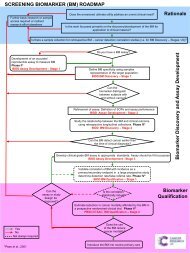
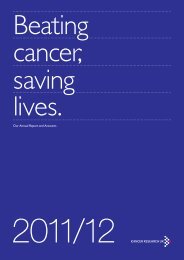


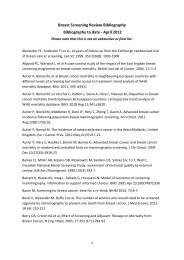
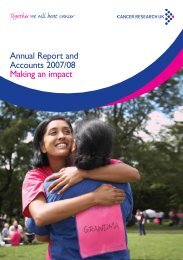



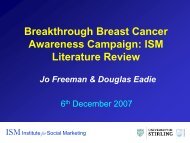
![[PDF] Cancer Research UK's strategy 2009 - 2014](https://img.yumpu.com/29239422/1/184x260/pdf-cancer-research-uks-strategy-2009-2014.jpg?quality=85)

